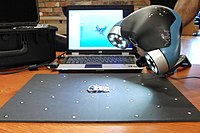
Photo from wikipedia
This research aimed to preserve traditional elements and urban fabric with enabled interaction in augmented reality (AR). Cultural elements and fabrics are mutually influential in Lukang, Taiwan. Evolved routes for… Click to show full abstract
This research aimed to preserve traditional elements and urban fabric with enabled interaction in augmented reality (AR). Cultural elements and fabrics are mutually influential in Lukang, Taiwan. Evolved routes for tourism and religious activities have created characteristic elements and activity-based fabrics and facilities. The sustainable promotion of digital cultural assets started from photogrammetry modeling of alley space and shops. The application of AR enabled situated learning of 68 objects, including decorated facades, jar walls, the Lukang Gate, beggar seats, and other creative cultural elements. The heritages were promoted under a new interactive measure of feasibility that facilitated cultural sustainability in a remote site. A mobile interface with a convenient smartphone configured certain settings that were sufficiently flexible and easy to apply. The study presented an effective and efficient remote and situated learning process that correlated the development or setting of both locations. Correlation was achieved with a high fidelity of appearance and utilizing a flexible transformation interface. An approach, which recreated the background and formerly reconstructed objects during AR simulation, was used to verify the outcome of the situated study with conflicting qualitative and quantitative findings.
Journal Title: Sustainability
Year Published: 2020
Link to full text (if available)
Share on Social Media: Sign Up to like & get
recommendations!